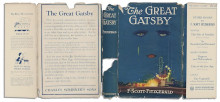Here’s the Story Behind the Original Cover of ‘The Great Gatsby’ and the Artist Who Created It

photo: First edition dust jacket of “The Great Gatsby,” 1925 (Photo: Wikimedia Commons, Public domain)
Few novels have achieved the same level of fame as The Great Gatsby. Originally published in 1925, this classic novel tells the story of an enigmatic millionaire Jay Gatsby who is driven by a romantic desire to reunite with his old lover, all the while commenting on social class, new and old money, and the American dream. Although first and foremost, author F. Scott Fitzgerald's masterpiece is renowned for its compelling tale, the book also features one of the most iconic covers in literature. It depicts a disembodied flapper's face hovering over a nighttime cityscape.




